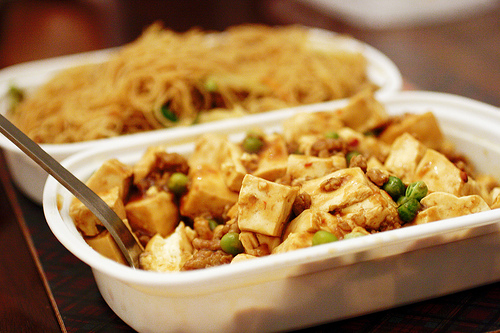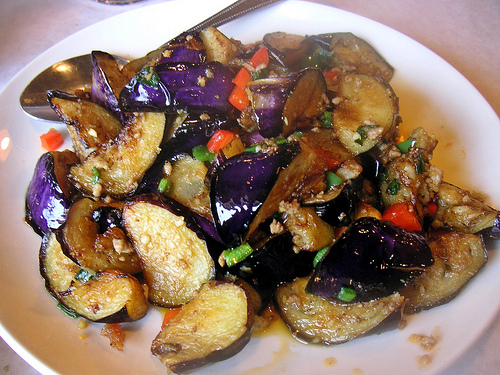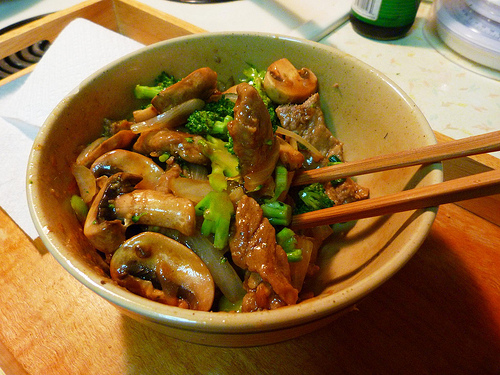Always Convenient, Rarely Healthy: How to Order a Healthy Chinese Food Delivery
In the middle of a busy work day, food delivery from a favorite takeout spot can be a lifesaver… until your meal leaves you zapped of energy, feeling overstuffed, and guilty for breaking your dietary goals. Isn’t lunch supposed to make you feel nourished and ready to take on the afternoon?

Image source: Flickr user RobynLee
Why is it so tricky to find healthy takeout orders? Thousand-calorie salads. Savory sauces full of sugar. And let’s not even get started on portion sizes. Really, any restaurant meal has the potential to be a diet-wrecker, but perhaps no cuisine is as problematic as the kind that arrives in a little white folded box. Vegetables, rice, shrimp, chicken: Chinese takeout sounds like it should be quite healthy, but that’s only true if you know what to look for. Many dishes that sound like smart choices are actually laden with more oil, salt, and sugar than you might imagine.
So let’s explore the takeout menu, and identify a few key strategies to making your Chinese food delivery a healthier one:
Watch out for:
Starting a meal with soup is usually a smart idea — but at most Chinese restaurants, they are loaded with sodium. A cup of hot and sour soup from P.F. Chang’s has 1,440 mg, which is pretty much what American Heart Association recommends we have all day (and that’s just a cup – the bowl has an unbelievable 7,980 mg of sodium).
Rice is perhaps the biggest nutritional land mine on a Chinese menu, mostly because of portion sizes. At Panda Express, a side of supposedly-healthy brown rice will add 420 calories to your meal! Ask for a half portion instead, and substitute mixed veggies for the rest of your “side dish”. White is similar in calorie content, but has less fiber… and you should probably just stay away from fried rice altogether.

Image source: Flickr user Helen ST
Another healthy-sounding menu item is eggplant, but when cooked in a wok, the spongy vegetable can soak up a lot of oil. At P.F. Chang’s, an order of stir-fried eggplant (listed under the noble Vegetarian Plates category) will cost you 1,010 calories and 88 grams of fat. By contrast, the stir-fried Buddha’s Feast only has 420 calories and 12 grams of fat.
Smarter choices:
When it comes to chicken, think ginger. Compared to orange chicken (loaded with sugar) or black bean sauce (high in sodium), ginger chicken is usually the healthiest poultry option on the menu. It’s typically lower in fat, too: at fast-casual chain Pei Wei, ginger chicken has 14 grams of fat, while Kung Pao has more than twice that with 29 grams.

Image source: Flickr user Rusty Clark
If you prefer red meat, beef with broccoli is usually your best bet; while beef will rarely be low-calorie, the ample serving of fresh broccoli makes it a wholesome lunch full of fiber and vitamins.
Another surprisingly healthy Chinese dish is shrimp with lobster sauce. While you might think lobster sauce will be creamy and thus loaded with fat, it’s actually a wine or broth-based sauce, and the shrimp is usually steamed or lightly stir-fried — often giving this dish half the fat of other shrimp dishes that are likely to be fried.
Don’t be afraid to ask questions or request customizations! Adding more vegetables and less meat is always a good idea (well, unless it’s eggplant). Some restaurants, like Pei Wei, offer a “stock velveted” or steamed cooking option, versus being cooked in oil, that can cut down significantly on fat content. Since most Chinese restaurants are privately owned and operated versus giant chains, nutrition details can vary widely depending on how much oil and seasoning is used during cooking… but many owners will be happy to accommodate special requests.
The easiest way to make your Chinese food delivery a healthy lunch? Grab a real plate from the break room, serve yourself a reasonable portion of your entree and a small helping of rice, and put the rest in the refrigerator. It will still be delicious tomorrow, and you’ll feel better — and be more productive — for the rest of the day. And with help from the experts at Waiter.com, it’s easy to have a quick meal delivered right to your office (or even your desk) so you can get back to work!